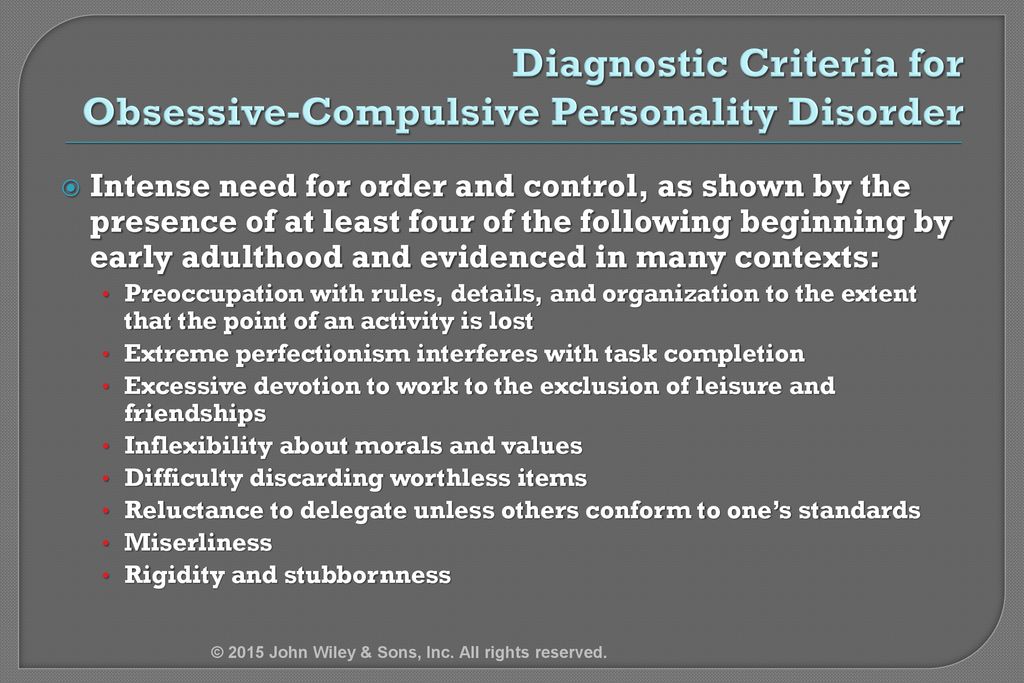

The inability to accept differences in beliefs or behaviors from others often leads to high conflict and controlling relationships with coworkers, spouses, and children. OCPD individuals may therefore punish those who violate their strict standards. Individuals with OCPD are referential to authority and rules. OCPD individuals present as over-controlled and this characteristic extends to the relationships they have with other people. While conscientiousness is a desirable trait generally, its extreme presentation for those with OCPD leads to interpersonal problems. Individuals with OCPD are at one extreme of the conscientiousness continuum. People with obsessive-compulsive personality disorder (OCPD) tend to be obsessed with controlling their environments to satisfy this need for control, they become preoccupied with trivial details, lists, procedures, rules, and schedules. Obsessive-compulsive personality disorder (OCPD) is marked by an excessive obsession with rules, lists, schedules, and order a need for perfectionism that interferes with efficiency and the ability to complete tasks a devotion to productivity that hinders interpersonal relationships and leisure time rigidity and zealousness on matters of morality and ethics and an inability to delegate responsibilities or work to others. Obsessive–compulsive personality disorder (OCPD) is a Cluster C personality disorder marked by an excessive need for orderliness, neatness, and perfectionism. Symptoms are usually present by the time a person reaches adulthood, and are visible in a variety of situations. People with OCPD may obsess over lists and rules. Obsessive-Compulsive Personality Disorderįigure 1. Pervasive need for perfectionism that interferes with the ability to complete tasks preoccupied with details, rules, order, and schedules excessively devoted to work at the expense of leisure and friendships rigid, inflexible, and stubborn insists things be done a certain way miserly with money Socially inhibited and oversensitive to negative evaluation avoids occupations that involve interpersonal contact because of fears of criticism or rejection avoids relationships with others unless guaranteed to be accepted unconditionally feels inadequate and views self as socially inept and unappealing unwilling to take risks or engage in new activities if they may prove embarrassingĪllows others to take over and run their life is submissive, clingy, and fears separation cannot make decisions without advice and reassurance from others lacks self-confidence cannot do things on his or her own feels uncomfortable or helpless when alone OCPD is different from the previously covered obsessive-compulsive disorder (OCD). Now we will explore the final cluster C personality disorder, obsessive-compulsive personality disorder (OCPD). Describe the characteristics and diagnosis of obsessive-compulsive personality disorder.© Copyright 2014 Physicians Postgraduate Press, Inc. This integrative perspective in OC-related pathology addresses the dimensional nature of traits and psychopathology and may improve the transparency and validity of assessment procedures. The current study empirically supports the classification of OCD and OCPD along a single dimension. OCD, and especially the obsessive symptom domain, can be considered as the extreme end of OCPD traits. The results support the continuity hypothesis, indicating that both OCD and OCPD can be represented along a single underlying spectrum. The validity of the continuity model for understanding the association between OCD and OCPD was explored in 787 Dutch community and referred adolescents (70% female, 12-20 years old, mean = 16.16, SD = 1.40) studied between July 2011 and January 2013, relying on item response theory (IRT) analyses of self-reported OCD symptoms (Youth Obsessive-Compulsive Symptoms Scale ) and OCPD traits (Personality Inventory for DSM-5 ). The current study aims to clarify whether this inclusion can be justified from an item response theory approach. Despite these shared characteristics, there is an ongoing debate on the inclusion of OCPD into the recently developed DSM-5 obsessive-compulsive and related disorders (OCRDs) category. Various studies have shown that obsessive-compulsive symptoms exist as part of not only obsessive-compulsive disorder (OCD) but also obsessive-compulsive personality disorder (OCPD).


 0 kommentar(er)
0 kommentar(er)
